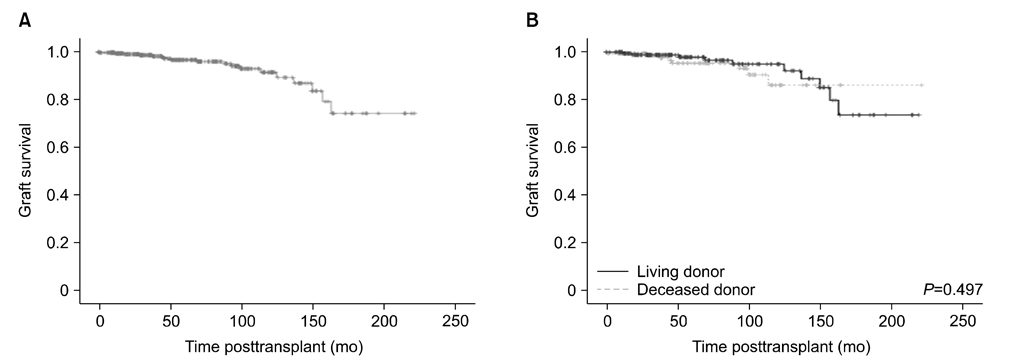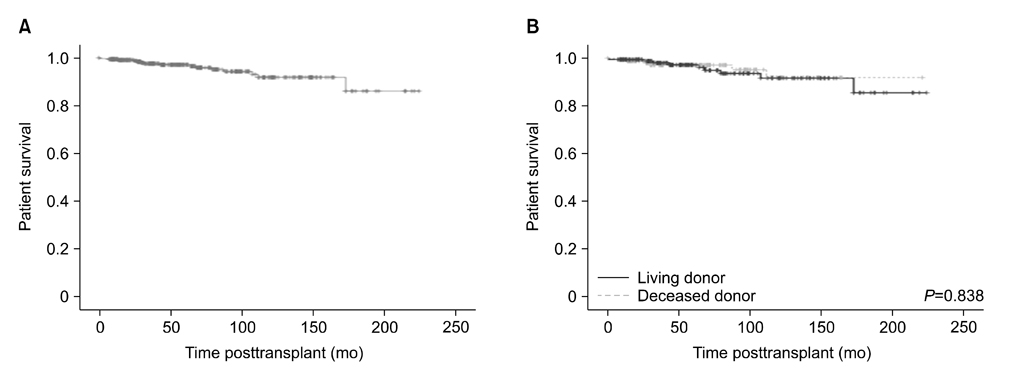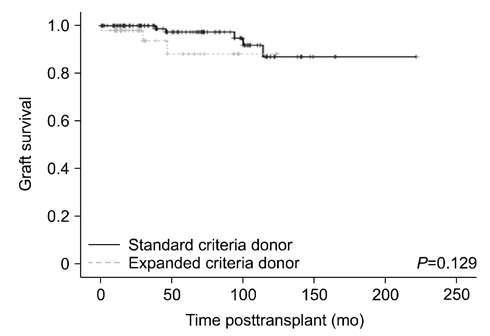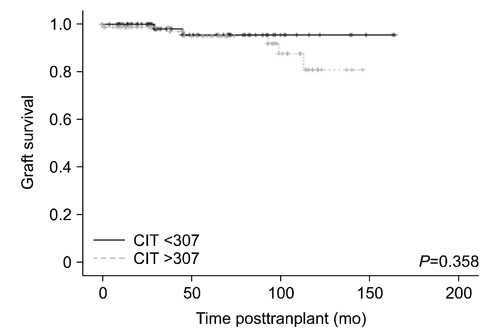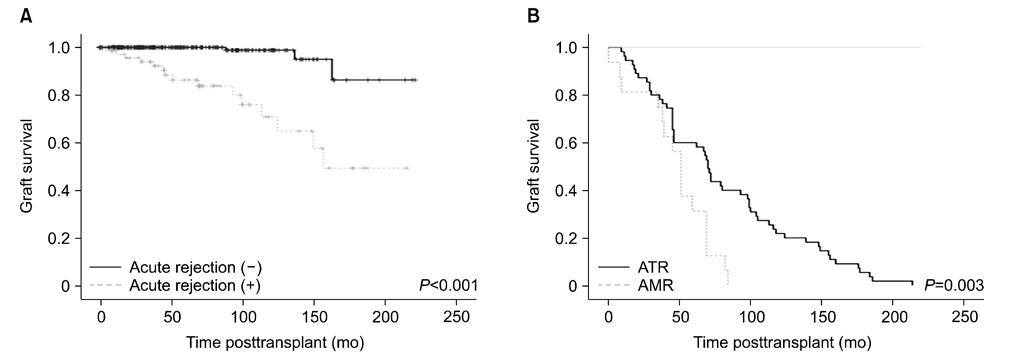J Korean Soc Transplant.
2017 Dec;31(4):182-192. 10.4285/jkstn.2017.31.4.182.
Clinical Outcomes and Contributors in Contemporary Kidney Transplantation: Single Center Experience
- Affiliations
-
- 1Division of Nephrology, Department of Internal Medicine, Ulsan University Hospital, University of Ulsan College of Medicine, Ulsan, Korea. jslee@uuh.ulsan.kr
- 2Biomedical Research Center, Ulsan University Hospital, University of Ulsan College of Medicine, Ulsan, Korea.
- 3Department of Surgery, Ulsan University Hospital, University of Ulsan College of Medicine, Ulsan, Korea.
- KMID: 2401569
- DOI: http://doi.org/10.4285/jkstn.2017.31.4.182
Abstract
- BACKGROUND
In recent years, introduction of novel immunosuppressive agents and its proper implementation for clinical practice have contributed to improving clinical outcomes of kidney transplantation (KT). Here, we report clinical outcomes of KTs and related risk factors.
METHODS
From July 1998 to June 2016, 354 KTs (182 from living and 172 from deceased donors) have been performed at Ulsan University Hospital. We retrospectively reviewed the clinical characteristics and outcomes of KT recipients, then estimated graft and patient survival rate were estimated and analyzed risk factors using Cox-regression.
RESULTS
The median follow-up period was 53 months (range; 3 to 220 months). The mean ages of recipients and donors were 45.0 years (SD, 12.5) and 44.7 years (SD, 13.6) years, respectively. During follow-up, 18 grafts were lost and 5- and 10-year death-censored graft survival was 96.7% and 91.5%, respectively. Biopsy-proven acute rejection (BPAR) occurred in 71 patients (55 cases of acute cellular rejection and 16 of antibody-mediated rejection). Cox-regression analysis showed that BPAR was a risk factor related to graft loss (hazard ratio [HR], 14.38; 95% confidence interval [CI], 3.79 to 54.53; P < 0.001). In addition, 15 patients died, and the 5- and 10-year patient survival was 97.2% and 91.9%, respectively. Age ≥60 years (HR, 6.03; 95% CI, 1.12 to 32.61; P=0.037) and diabetes (HR, 6.18; 95% CI, 1.35 to 28.22; P=0.019) were significantly related to patient survival.
CONCLUSIONS
We experienced excellent clinical outcomes of KT in terms of graft failure and patient survival despite the relatively high proportion of deceased donors. Long-term and short-term clinical outcomes have improved in the last two decades.
MeSH Terms
Figure
Reference
-
1. Suthanthiran M, Strom TB. Renal transplantation. N Engl J Med. 1994; 331:365–376.
Article2. Schnuelle P, Lorenz D, Trede M, Van Der. Impact of renal cadaveric transplantation on survival in end-stage renal failure: evidence for reduced mortality risk compared with hemodialysis during long-term follow-up. J Am Soc Nephrol. 1998; 9:2135–2141.
Article3. Gonwa T, Johnson C, Ahsan N, Alfrey EJ, Halloran P, Stegall M, et al. Randomized trial of tacrolimus+mycophenolate mofetil or azathioprine versus cyclosporine+mycophenolate mofetil after cadaveric kidney transplantation: results at three years. Transplantation. 2003; 75:2048–2053.
Article4. Metzger RA, Delmonico FL, Feng S, Port FK, Wynn JJ, Merion RM. Expanded criteria donors for kidney transplantation. Am J Transplant. 2003; 3:Suppl 4. 114–125.
Article5. Ekberg H, Bernasconi C, Tedesco-Silva H, Vitko S, Hugo C, Demirbas A, et al. Calcineurin inhibitor minimization in the Symphony study: observational results 3 years after transplantation. Am J Transplant. 2009; 9:1876–1885.
Article6. Knight SR, Russell NK, Barcena L, Morris PJ. Mycophenolate mofetil decreases acute rejection and may improve graft survival in renal transplant recipients when compared with azathioprine: a systematic review. Transplantation. 2009; 87:785–794.
Article7. Pippias M, Kramer A, Noordzij M, Afentakis N, Alonso de, Ambuhl PM, et al. The European Renal Association-European Dialysis and Transplant Association Registry Annual Report 2014: a summary. Clin Kidney J. 2017; 10:154–169.8. Korean Network for Organ Sharing (KONOS). 2015 Annual data report [Internet]. Seoul: KONOS;c2012. cited 2017 Nov 27. Available from: http://konos.go.kr.9. Saran R, Robinson B, Abbott KC, Agodoa LY, Albertus P, Ayanian J, et al. US Renal Data System 2016 Annual Data Report: epidemiology of kidney disease in the United States. Am J Kidney Dis. 2017; 69:3 Suppl 1. A7–A8.10. Gondos A, Dohler B, Brenner H, Opelz G. Kidney graft survival in Europe and the United States: strikingly different long-term outcomes. Transplantation. 2013; 95:267–274.11. Debout A, Foucher Y, Trebern-Launay K, Legendre C, Kreis H, Mourad G, et al. Each additional hour of cold ischemia time significantly increases the risk of graft failure and mortality following renal transplantation. Kidney Int. 2015; 87:343–349.
Article12. Korean Network for Organ Sharing (KONOS). Regulations and guidelines for organ transplantation [Internet]. Seoul: KONOS;c2012. cited 2017 Nov 27. Available from: http://konos.go.kr.13. Hong JW, Shin M, Moon HH, Lee S, Kim JM, Park JB, et al. Analysis of 1,500 kidney transplantations at Sungkyunkwan University. J Korean Soc Transplant. 2014; 28:25–35.
Article14. Kim JY, Kim SH, Kim YS, Choi BS, Kim JC, Park SC, et al. Report of 1,500 kidney transplants at the Catholic University of Korea. J Korean Soc Transplant. 2006; 20:172–180.15. Kim YS, Kim SI, Kim MS, Huh KH, Ju MK, Joo DJ, et al. Evaluation of independent risk factors affecting renal allograft survival by transplant era. J Korean Soc Transplant. 2012; 26:178–187.
Article16. Korean Network for Organ Sharing (KONOS). Current status of organ transplantation [Internet]. Seoul: KONOS;c2012. cited 2017 Nov 27. Available from: http://konos.go.kr.17. ESRD Registry Committee, Korean Society of Nephrology. Current renal replacement therapy in Korea 2015 [Internet]. Seoul: Korean Society of Nephrology;c2016. cited 2017 Nov 27. Available from: http://www.ksn.or.kr.18. Matas AJ, Smith JM, Skeans MA, Thompson B, Gustafson SK, Stewart DE, et al. OPTN/SRTR 2013 Annual Data Report: kidney. Am J Transplant. 2015; 15:Suppl 2. 1–34.
Article19. Chung UK, Cho WH, Kim HT, Koo JH, Joo SH, Hwang EA, et al. Cadaveric renal transplantation, before and after KONOS system (Single Center Report). J Korean Soc Transplant. 2004; 18:171–178.20. Serur D, Saal S, Wang J, Sullivan J, Bologa R, Hartono C, et al. Deceased-donor kidney transplantation: improvement in long-term survival. Nephrol Dial Transplant. 2011; 26:317–324.
Article21. Lodhi SA, Meier-Kriesche HU. Kidney allograft survival: the long and short of it. Nephrol Dial Transplant. 2011; 26:15–17.
Article22. The Tricontinental Mycophenolate Mofetil Renal Transplantation Study Group. A blinded, randomized clinical trial of mycophenolate mofetil for the prevention of acute rejection in cadaveric renal transplantation. Transplantation. 1996; 61:1029–1037.23. Meier-Kriesche HU, Schold JD, Srinivas TR, Kaplan B. Lack of improvement in renal allograft survival despite a marked decrease in acute rejection rates over the most recent era. Am J Transplant. 2004; 4:378–383.
Article24. Sollinger HW. U.S. Renal Transplant Mycophenolate Mofetil Study Group. Mycophenolate mofetil for the prevention of acute rejection in primary cadaveric renal allograft recipients. Transplantation. 1995; 60:225–232.
Article25. Matas AJ, Kandaswamy R, Gillingham KJ, McHugh L, Ibrahim H, Kasiske B, et al. Prednisone-free maintenance immunosuppression-a 5-year experience. Am J Transplant. 2005; 5:2473–2478.
Article26. Sellares J, de Freitas DG, Mengel M, Reeve J, Einecke G, Sis B, et al. Understanding the causes of kidney transplant failure: the dominant role of antibody-mediated rejection and nonadherence. Am J Transplant. 2012; 12:388–399.
Article27. Vereerstraeten P, Abramowicz D, de Pauw L, Kinnaert P. Absence of deleterious effect on long-term kidney graft survival of rejection episodes with complete functional recovery. Transplantation. 1997; 63:1739–1743.
Article28. Cosio FG, Grande JP, Wadei H, Larson TS, Griffin MD, Stegall MD. Predicting subsequent decline in kidney allograft function from early surveillance biopsies. Am J Transplant. 2005; 5:2464–2472.
Article29. Gago M, Cornell LD, Kremers WK, Stegall MD, Cosio FG. Kidney allograft inflammation and fibrosis, causes and consequences. Am J Transplant. 2012; 12:1199–1207.
Article30. Gloor JM, Sethi S, Stegall MD, Park WD, Moore SB, DeGoey S, et al. Transplant glomerulopathy: subclinical incidence and association with alloantibody. Am J Transplant. 2007; 7:2124–2132.
Article31. Moreso F, Ibernon M, Goma M, Carrera M, Fulladosa X, Hueso M, et al. Subclinical rejection associated with chronic allograft nephropathy in protocol biopsies as a risk factor for late graft loss. Am J Transplant. 2006; 6:747–752.
Article32. Butler JA, Roderick P, Mullee M, Mason JC, Peveler RC. Frequency and impact of nonadherence to immunosuppressants after renal transplantation: a systematic review. Transplantation. 2004; 77:769–776.
Article33. Pascual J, Zamora J, Pirsch JD. A systematic review of kidney transplantation from expanded criteria donors. Am J Kidney Dis. 2008; 52:553–586.
Article34. Querard AH, Foucher Y, Combescure C, Dantan E, Larmet D, Lorent M, et al. Comparison of survival outcomes between expanded criteria donor and standard criteria donor kidney transplant recipients: a systematic review and meta-analysis. Transpl Int. 2016; 29:403–415.
Article35. Park JY, Cho JH, Yoon YD, Song EJ, Jin MK, Yu CH, et al. Outcome of cadaveric kidney transplantation from expanded criteria donors. Korean J Med. 2011; 80:408–418.36. Yang SS, Yang J, Ahn C, Min SI, Ha J, Kim SJ, et al. The need for new donor stratification to predict graft survival in deceased donor kidney transplantation. Yonsei Med J. 2017; 58:626–630.
Article37. Park UJ, Cho WH, Kim HT, Kim MY, Kim YL, Kim CD, et al. Evaluation of the Korean Network for Organ Sharing expanded donor criteria in deceased donor renal transplantation. J Korean Soc Transplant. 2013; 27:166–173.
Article
- Full Text Links
- Actions
-
Cited
- CITED
-
- Close
- Share
- Similar articles
-
- BK polyomavirus infection following COVID-19 infection in renal transplant recipients: a single-center experience
- Kidney Allocation: Present Status and Future Strategy
- Successful robotic kidney transplantation for surgeons with no experience in minimally invasive surgery: a single institution experience
- ABO Incompatible Kidney Transplantation
- Clinical Outcomes of Spousal Donor Kidney Transplantation: Single Center Experience

